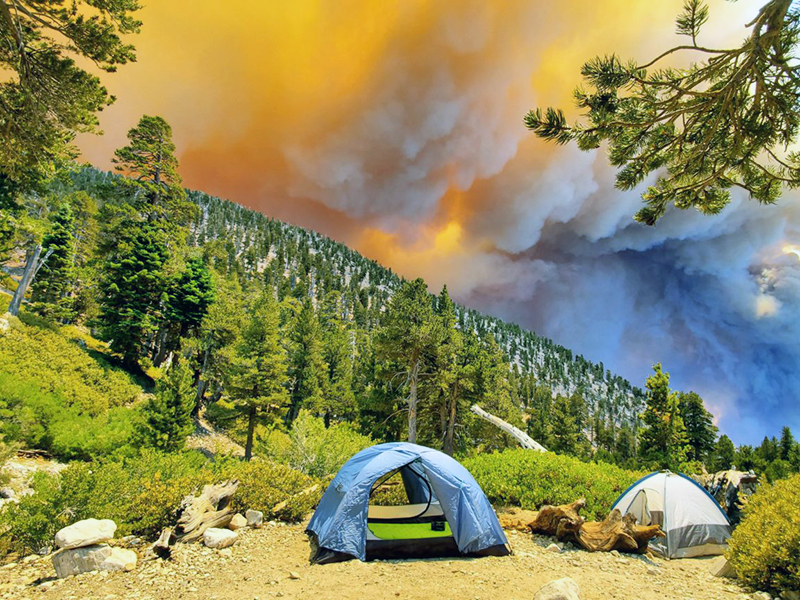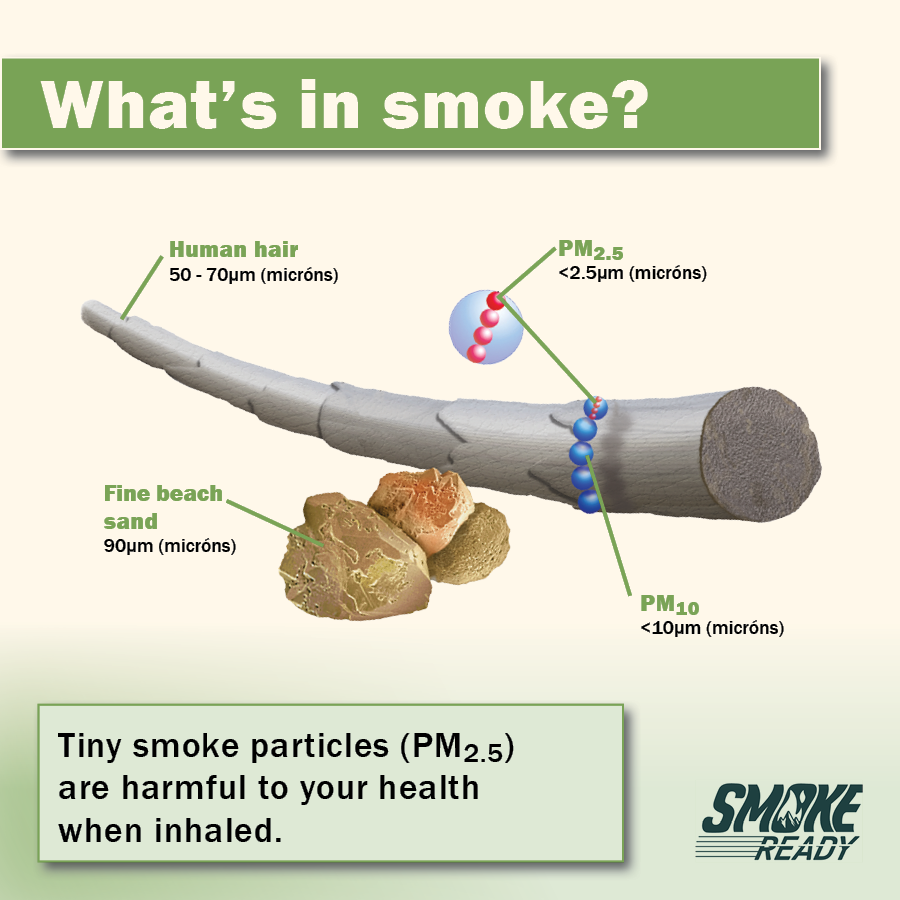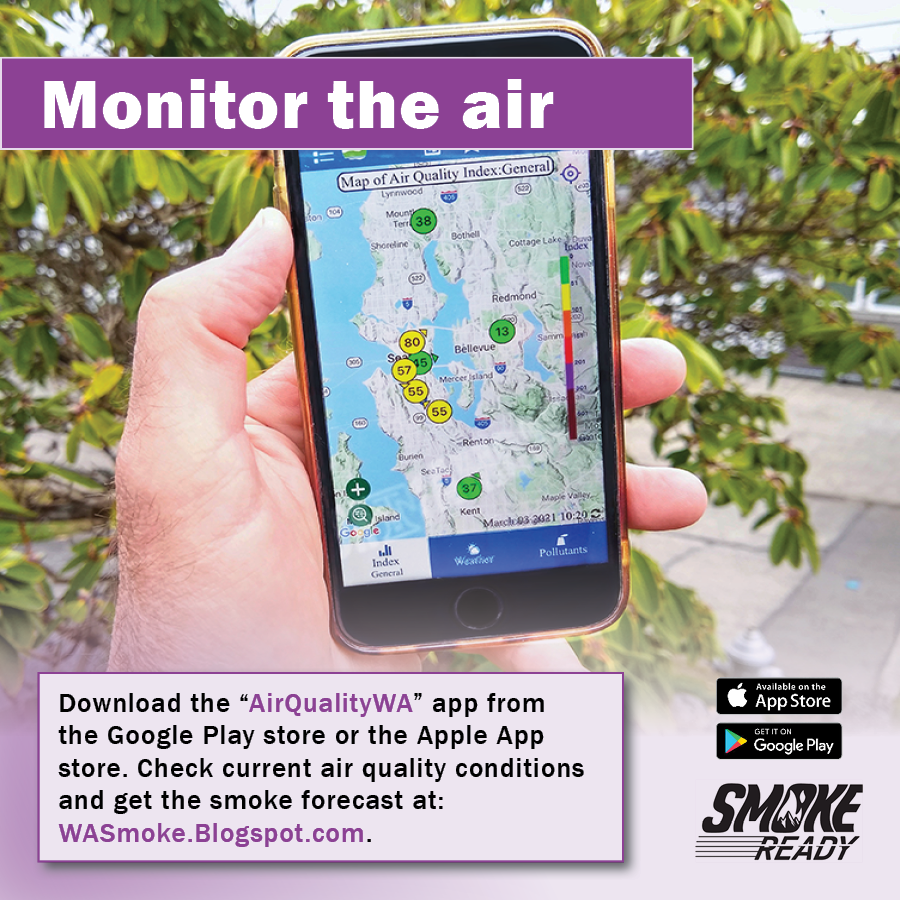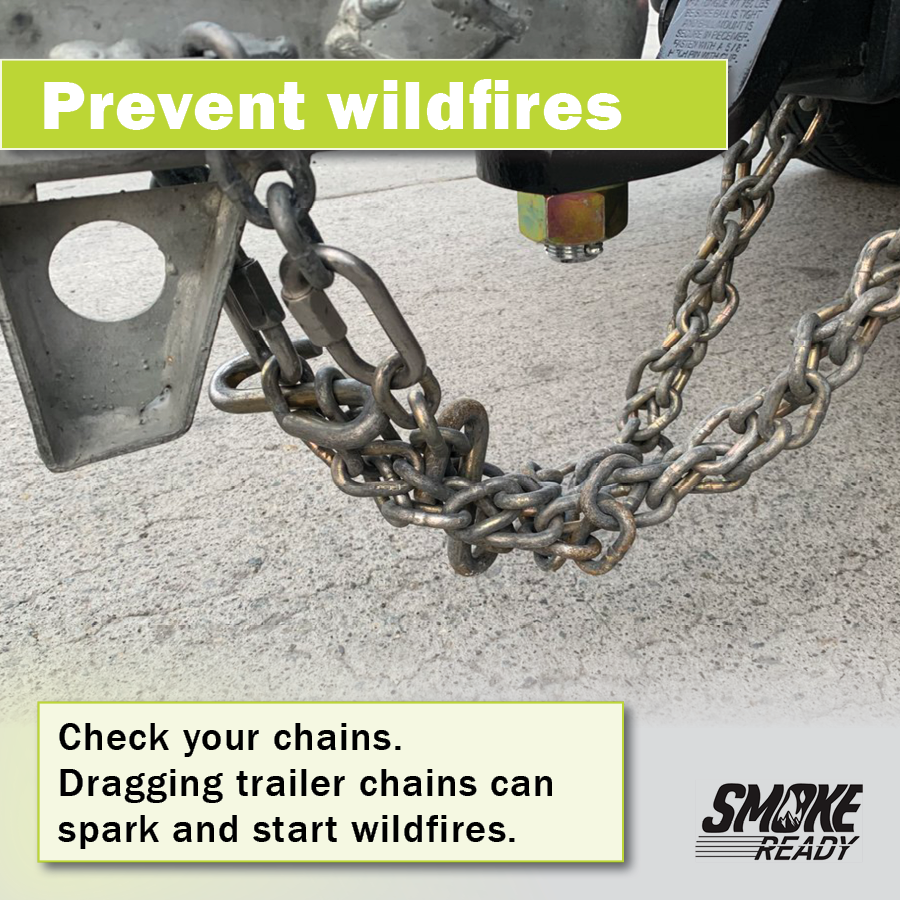
Summer is coming and #SmokeReady week is the ideal time to prepare for wildfire season. Follow these tips to stay safe when camping, hiking, and exploring Washington's natural beauty.
Monday – What's in smoke?
The most common air pollution Ecology and local clean air agencies monitor is known as particulate matter (PM). PM is a mixture of tiny solids or liquid droplets of smoke, soot, dirt, and dust floating in the air. These tiny particles can harm your health when inhaled. PM mostly comes from wood stoves, outdoor burning, wildfires, blowing dust, and vehicle and industry emissions.
Wildfire smoke is made up of particulate matter and gases and can be dangerous to your health when inhaled. In addition, carbon monoxide from smoke is risky to people who live, work, and recreate near areas that are smoldering.
Tuesday – Resources
There are many ways to monitor air quality and get a smoke forecast.
State resources:
- Washington Smoke Blog – The WA Smoke Blog is a one-stop website for all things related to smoke and fire. It's managed by a partnership between state, county, and federal agencies, as well as Tribes. The site contains smoke, fire, and health information, emergency management contacts, and a map of current air quality conditions, based on data provided by the Environmental Protection Agency’s (EPA) Air Quality Index (AQI).
- Washington Smoke Forecast map – This Smoke Forecast Map predicts smoke levels created by wildfires and other sources across Washington. Forecasts may give up to five days advance notice, so you can plan outdoor activities and reduce exposure to air pollution.
- Mobile – Download the “AirQualityWA” app from the Google Play Store or Apple App store to monitor air quality in your area.
Federal resources:
- AirNow – AirNow is a federal tool that also uses the EPA’s AQI to report air quality. It uses color-coded categories and a numeric value to show air quality ranges from good to hazardous.
- InciWeb – InciWeb is an interagency information map provided by the United States Forest Service for wildfires. It’s also used for other natural disasters, such as earthquakes, floods, hurricanes, and tornadoes.
- Wireless Emergency Alerts – Sign up for FEMA Wireless Emergency Alerts for messages sent directly to your cell phone.
- Smoke Ready Toolbox – Visit the EPA website for additional information to help you prepare for wildfire smoke.
In addition, you should always have an emergency plan ready, watch for alerts, and follow evacuation orders during wildfire season. Ready, Set, GO! Is a good resource for emergency preparedness tips.
Wednesday – How smoke affects your health
Even if you are healthy, smoke can cause:
- Watery or dry eyes.
- Lung and sinus irritation.
- Coughing, phlegm.
- Shortness of breath and wheezing.
- Headaches.
- Irregular heartbeat, chest pain, or fatigue.
- Non-fatal and fatal heart attacks.
Symptoms may be worse for people with pre-existing health conditions. If you are in one of the groups below, seek medical attention if your condition worsens during a smoke event:
- People with lung diseases and respiratory infections
- People with existing heart or circulatory problems
- People with a history of heart attack or stroke
- People with diabetes
- Infants and children under age 18
- Adults over age 65
- Pregnant people
- People who smoke
Thursday – Smoke exposure
If you are indoors when the air is smoky:
- Avoid burning anything inside your home (cigarettes, candles, incense).
- Delay vacuuming and dusting.
- Keep windows and doors closed; use a fan to keep cool.
- Use a high-efficiency particulate air (HEPA) filter to reduce indoor air pollution.
- Set your air conditioner to recirculate.
- Make a low-cost, effective clean air fan.
If you are outdoors:
- Reconsider activities if you are in a sensitive group.
- Delay mowing your lawn, filling up your gas tank, or doing strenuous activity until the air is clear.
- Protect your eyes with goggles.
- Use artificial tear drops for irritated eyes.
- Drink plenty of water.
- Take an over-the-counter pain reliever for headaches.
- Set your vehicle’s air conditioner to recirculate.
- Use an N95 respirator mask. These masks filter 95 percent of smoke particles, but they do not protect from toxic gases.
- Respirator masks must be properly fitted, so children and men with beards may not benefit from their use.
- If you are in a sensitive group, check with your doctor before using a mask.
- Wet towels and bandanas do not provide protection from particulate matter.
- Consider leaving the affected area, if possible.
Protect animals:
- Reduce the time your animal companions spend outdoors.
- Limit activities that will increase your animal's breathing.
- If your animal is coughing or having difficulty breathing, contact your veterinarian.
- Provide pets and wildlife with plenty of water.
Friday – Prevent wildfires
Increasing temperatures due to climate change, drought, and smaller winter snowpacks mean fires can ignite more easily. Dry conditions help fires spread more rapidly and burn more intensely, making them harder to extinguish.
More than 80 percent of U.S. wildfires are started by people, whether by accident, negligence, or intentionally. Preventing wildfires is something we can do together by following these simple guidelines:
- Extinguish campfires completely by saturating them with water, stirring, and adding more water until all embers are out.
- Follow burn bans.
- Avoid burning yard waste when it's windy.
- Use alternatives to burning, such as composting, bagging, or chipping your yard waste.
- Use an ashtray to fully extinguish cigarette butts.
- Keep the perimeter of your house and gutters free from pine and fir needles and other vegetation that can easily ignite.
- Equip your ATV with a spark arrestor and carry an extinguisher.
- Park your hot vehicle on pavement rather than dry grass.
- Check your trailer chains. Chains that drag can spark and start brush fires.
Burn bans
There are two types of burn bans in Washington:
- Fire safety burn bans – When dry conditions persist, local fire departments, land managers, or county emergency management agencies will call fire safety burn bans.
- Air quality burn bans – Ecology and local clean air agencies may call air quality burn bans when smoke levels are extremely high. Air quality burn bans are typically called in the winter months, when smoke from wood stoves sticks close to the ground.
Ecology compiles burn bans we know about on a Washington burn bans webpage. When wildfire risk is high, burn bans may restrict the use of campfires, charcoal, gas/propane grills, and agricultural burning. Always check with local authorities before burning of any kind during wildfire season — which is getting longer due to climate change.
Burning in an urban growth area
Most burning is illegal in an urban growth area. An urban growth area is land used for urban development in and around communities. Even if you live outside city limits, you may still live inside an urban growth area. Land outside an urban growth area (including agricultural, rural, and natural land) is protected from urban sprawl. Visit this webpage to determine if you are located in an urban growth area.
If you see someone burning during wildfire season, or if you are being impacted by poor air quality caused by smoke, report it!
Together, we can help prevent wildfires and minimize the effects of the smoke they generate. Share this blog with a friend and ensure they are #SmokeReady, too! Have a safe and enjoyable summer!






